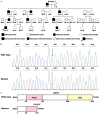SOX7 loss-of-function variation as a cause of familial congenital heart disease
- PMID: 35422912
- PMCID: PMC8991148
SOX7 loss-of-function variation as a cause of familial congenital heart disease
Abstract
Introduction: As the most frequent type of birth defect in humans, congenital heart disease (CHD) leads to a large amount of morbidity and mortality as well as a tremendous socioeconomic burden. Accumulating studies have convincingly substantiated the pivotal roles of genetic defects in the occurrence of familial CHD, and deleterious variations in a great number of genes have been reported to cause various types of CHD. However, owing to pronounced genetic heterogeneity, the hereditary components underpinning CHD remain obscure in most cases. This investigation aimed to identify novel genetic determinants underlying CHD.
Methods and results: A four-generation pedigree with high incidence of autosomal-dominant CHD was enrolled from the Chinese Han race population. Using whole-exome sequencing and Sanger sequencing assays of the family members available, a novel SOX7 variation in heterozygous status, NM_031439.4: c.310C>T; p.(Gln104*), was discovered to be in co-segregation with the CHD phenotype in the whole family. The truncating variant was absent in 500 unrelated healthy subjects utilized as control individuals. Functional measurements by dual-luciferase reporter analysis revealed that Gln104*-mutant SOX7 failed to transactivate its two important target genes, GATA4 and BMP2, which are both responsible for CHD. In addition, the nonsense variation invalidated the cooperative transactivation between SOX7 and NKX2.5, which is another recognized CHD-causative gene.
Conclusion: The present study demonstrates for the first time that genetically defective SOX7 predisposes to CHD, which sheds light on the novel molecular mechanism underpinning CHD, and implies significance for precise prevention and personalized treatment in a subset of CHD patients.
Keywords: Congenital heart disease; SOX7; dual-luciferase analysis; medical genetics; transcriptional regulation.
AJTR Copyright © 2022.
Conflict of interest statement
None.
Figures



References
-
- Virani SS, Alonso A, Aparicio HJ, Benjamin EJ, Bittencourt MS, Callaway CW, Carson AP, Chamberlain AM, Cheng S, Delling FN, Elkind MSV, Evenson KR, Ferguson JF, Gupta DK, Khan SS, Kissela BM, Knutson KL, Lee CD, Lewis TT, Liu J, Loop MS, Lutsey PL, Ma J, Mackey J, Martin SS, Matchar DB, Mussolino ME, Navaneethan SD, Perak AM, Roth GA, Samad Z, Satou GM, Schroeder EB, Shah SH, Shay CM, Stokes A, Van Wagner LB, Wang NY, Tsao CW American Heart Association Council on Epidemiology and Prevention Statistics Committee and Stroke Statistics Subcommittee. Heart disease and stroke statistics - 2021 update: a report from the American Heart Association. Circulation. 2021;143:e254–e743. - PubMed
-
- Virani SS, Alonso A, Benjamin EJ, Bittencourt MS, Callaway CW, Carson AP, Chamberlain AM, Chang AR, Cheng S, Delling FN, Djousse L, Elkind MSV, Ferguson JF, Fornage M, Khan SS, Kissela BM, Knutson KL, Kwan TW, Lackland DT, Lewis TT, Lichtman JH, Longenecker CT, Loop MS, Lutsey PL, Martin SS, Matsushita K, Moran AE, Mussolino ME, Perak AM, Rosamond WD, Roth GA, Sampson UKA, Satou GM, Schroeder EB, Shah SH, Shay CM, Spartano NL, Stokes A, Tirschwell DL, Van Wagner LB, Tsao CW American Heart Association Council on Epidemiology and Prevention Statistics Committee and Stroke Statistics Subcommittee. Heart disease and stroke statistics - 2020 update: a report from the American Heart Association. Circulation. 2020;141:e139–e596. - PubMed
-
- Moons P, Luyckx K, Thomet C, Budts W, Enomoto J, Sluman MA, Lu CW, Jackson JL, Khairy P, Cook SC, Chidambarathanu S, Alday L, Eriksen K, Dellborg M, Berghammer M, Johansson B, Mackie AS, Menahem S, Caruana M, Veldtman G, Soufi A, Fernandes SM, White K, Callus E, Kutty S, Ombelet F, Apers S, Kovacs AH APPROACH-IS Consortium and the International Society for Adult Congenital Heart Disease (ISACHD) Physical functioning, mental health, and quality of life in different congenital heart defects: comparative analysis in 3538 patients from 15 countries. Can J Cardiol. 2021;37:215–223. - PubMed
LinkOut - more resources
Full Text Sources
Research Materials
